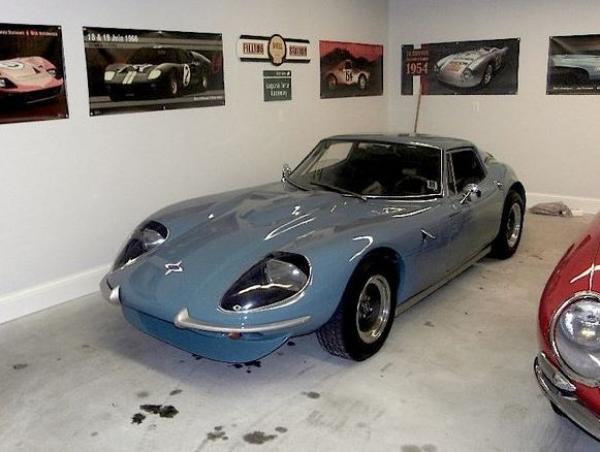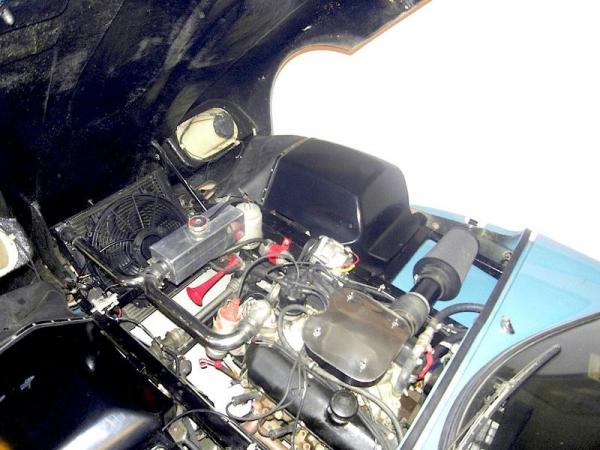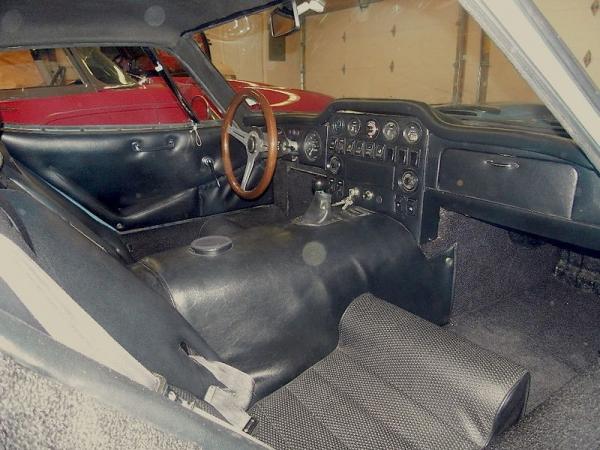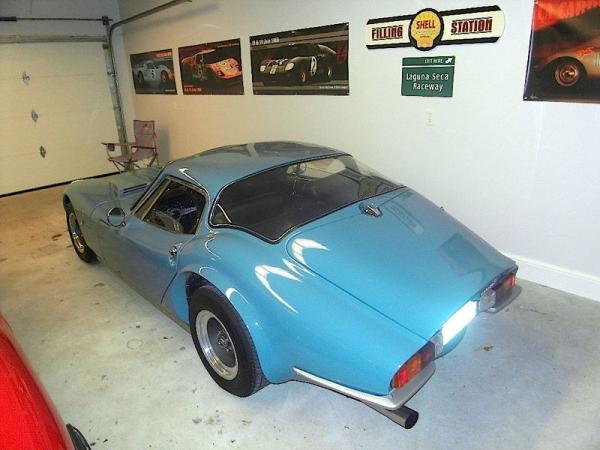
The Marcos Motor Company is best known for their wild designs, racing success, and their unique wood construction. This 1970 Marcos GT 3.0 has that unique Marcos styling and the racing pedigree, but not the wooden chassis. In 1969 Marcos began developing a steel frame, which was both stronger and more durable. The 1970 GT was the first of the Marcos to receive this new frame, which allowed the car to be fitted with a wide range of engines.

The GT could be ordered from the factory with anything from a Ford four cylinder to a Volvo straight six. This particular car is powered by a Ford 3.0 V6, which was the largest of the engine options available in the GT. This engine wasn’t extremely powerful from the Ford factory, but could easily be tuned to produce considerable power. As it sits, this engine probably only produces 150 horsepower or so. But the Marcos GT’s fiberglass body is very light, giving this car a total weight of around 2,000 pounds.

Having great styling and a decent power to weight ratio means nothing without a sporty interior. This car’s interior is similar to many of its British sports car cousins, but is a bit more aggressive than most. The built in seats have lots of bolster for good support and sit very low to keep the center of gravity close to the ground. This means the transmission tunnel sits very high, creating a massive barrier between the seats and making the cockpit very tight. We imagine it would feel like sitting in any of the finest Italian Supercars of the era. The seller claims that a 6’4″ person fits comfortably inside, but we imagine that ingress might be a different story.

The seller has a Jaguar E-type parked in the garage which looks massive next to this car. This leads us to believe they have at least a small grasp on the workings of British sports cars, so hopefully they have kept this car well maintained. It looks fantastic and could be one of the cleanest Marcos GT 3.0s out there. The car is located in Halifax Nova Scotia, Canada and the seller has listed it here on eBay. They are asking $29,000 for it, but are willing to except offers. This BIN seems reasonable for a rare car that’s in such exceptional condition. The wood would make for good conversation, but we would much rather have this one.


Another interesting car forbidden to us Yanks by safety and emissions laws.
Good Lookin’ Car!!I like how the seller included a few detailed pics of the underside and the engine bay.SO GLAD he hasn’t installed the “fabric sunroof” that is mentioned in the listing!! (“why the heck would you want to cut into this body?!?”)& I was so amused by the “oil on the floor” disclaimer!(Any owner of a 50’s or 60’s British sport car would COMPLETELY understand!!)I hope it goes to a good home! :-)
Without sunroof you wouldn’t be able to survive the heat wave from the V6 Essex… Ask owners!
“J.Pickett”FYI: Your comment is incorrect for a vehicle of this age:?ÇóIf the vehicle is at least 21 years old, there are no EPA compliance requirements upon importation.?ÇóIf the vehicle is 25 years old or more, it does not have to comply with the DOT’s Federal Motor Vehicle Safety Standards (FMVSS) to be imported permanently. The age of the vehicle is determined by subtracting the calendar year of manufacture from the calendar year of importation….https://help.cbp.gov/app/answers/detail/a_id/278/~/importing-classic-or-antique-vehicles-%2F-cars-for-personal-use
I knew a guy in the ’70s who had a Marcos GT exactly like this one but with the straight-6 Volvo engine. He bought it in Europe, drove it across a number of European countries, and then brought it back to Vancouver, Canada. He said it was the most fantastic trip of his life, and I guess doing the Autobahn in it would lead someone to say that. I remember seeing it parked in the rain in Vancouver many times near where I parked, and it looked fabulously exotic. But these were somewhat crude creations, especially inside, and similar to TVRs in that respect. If you are used to a modern car, especially from Europe like an Audi, BMW, or even generic “car”, like a recent Camry, these will look unappealing inside in comparison. And there is too much front overhang for my taste, especially given that short V6 in there, but they couldn’t have a different chassis and front end design for every possible engine they offered, could they? And there are many other interesting vehicles that the $29K asked for this car would buy, so it would not tempt me. On the other hand, you will not likely see a similar car coming down the road in your lifetime if you go for this one. But, exclusivity at a big price……
Hell of a barn; I wonder what his garage looks like.
Dear Bear, I am aware of waivers for older vehicles. Marcos were never really actively imported, and starting in the late 60’s emissions and later fear of safety regs made small manufacturers decide not to attempt to get in. Even in the Pre-emissions days they probably would have had expense in the form of glass and lighting expenses which discouraged them. At any rate Marcos, TVR, many very small companies left the market or never entered it. Even large mfg’s like Benz offered much different engine and model choices here.
Can you imagine this with a small block V8 in it?
This car is very interesting to me. I really like the E-type/Vette-ish styling, and the low stance. I wonder how easy an engine swap would be as the Ford V6 would have to go. The Volvo six would be the one to have, I would think. A small-block would be overkill with the 2000 lb. weight.
Put a Jag Inline 6 4.0L Supercharged and modify the exhaust to dual (quad tips) and you have a mini Pantera, plus of course other mods.
Forget the engine swaps, they would just ruin the purpose of the car. The Brits have many speed parts available for this engine as it was popular for transplants and used in a number of low production cars.
I completely agree with J.Pickett’s last comment.This is a small lightweight car that the existing 3.0L engine should be more than capable of providing spirited performance for.I’d opt to perhaps improve the performance of the existing engine, keep the car as original as possible, and preserve its integrity.Adding more engine weight would change the car’s weight balance and probably ruin the car’s handling.Sometimes less is more.
The Marcos is a very low car. The roof came up about to my waist. I doubt that it could take the inline 6 Jag engine, or even an American V8, without a big blister on the hood. Keep the light weight and balance…..
Jeez, another sbc comment. It is a sports car not a drag racer! Why do so many people want to do this to a light weight “handling” car? Are they so limited that the only sport to them is going fast in a staright line? If so then why a small block, Why not go whole hog and put a 502 crate motor with a big fat blower sticking out….oooooooh wow!
Pull the V6? what?……….do some of your realize what can be done too a Ford V6? “ah hell Homer……….let’s put a Chevy in her and replace the interior with gray cloth…………..oh’ and some big wide rims……….now what did I do with that glass o’ shine?”I do indeed like this car………and color? spot on.
We have a ’70 Marcos GT w/volvo engine. Bought it in early 70’s in Memphis from past president of Sportscar Club of America. Though I drove it in Memphis, we’re now restoring it now. No problem with having it tagged in US. Have to replace the front windshield (only place we’ve found one is at Marcos Heritage Parts in UK though I did send email to a “Nico” in Netherlands who has parts). Think we’ve found the interior light lens cover we’ve been looking for.
I had a 3 litre in 1970. It was built as a kit by the UK chairman of Honeywell computers, who sold it with his house when he moved back to the states. It would not catch an Elan on acceleration but was better on top speed. Almost exactly the same performance as a 3 litre TVR.
There were some problems: Marcos only allowed space for a 1000cc Ford Anglia battery and on a cold English morning it would not start.
The front hinged bonnet was secured by two Triumph Spitfire catches. With the flexing of the fibreglass bonnet, the catches would pop open at speed and the bonnet would rise until the back edge was in line with the top of the windscreen which could be exciting at 100 mph!
The seat cushion was fixed but the pedals were adjustable. As the foam seat cushion was sitting on the GRP floor, and the car sat very low, ‘bottoming’ cracked the glass. In wet weather, when one vacated the car, the foam seat would suck water through the floor, which would be expelled onto the driver’s posterior on his next visit.
Oh, and the perspex headlamp covers misted up.
Otherwise a good sports car, handled well, sounded great and one could imagine that it was something more exotic.